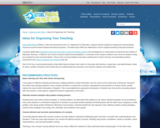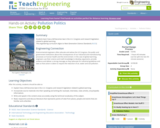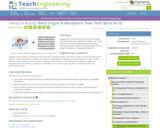
This scrollable interactive shows how an abstract of a research article is a
shortened version of the study.
- Subject:
- Biology
- Science
- Material Type:
- Interactive
- Provider:
- LabXchange
- Provider Set:
- LabXchange Interactives
- Date Added:
- 09/18/2019

This scrollable interactive shows how an abstract of a research article is a
shortened version of the study.

Biology 2e is designed to cover the scope and sequence requirements of a typical two-semester biology course for science majors. The text provides comprehensive coverage of foundational research and core biology concepts through an evolutionary lens. Biology includes rich features that engage students in scientific inquiry, highlight careers in the biological sciences, and offer everyday applications. The book also includes various types of practice and homework questions that help students understand—and apply—key concepts. The 2nd edition has been revised to incorporate clearer, more current, and more dynamic explanations, while maintaining the same organization as the first edition. Art and illustrations have been substantially improved, and the textbook features additional assessments and related resources.


By the end of this section, you will be able to do the following:
Identify the shared characteristics of the natural sciences
Summarize the steps of the scientific method
Compare inductive reasoning with deductive reasoning
Describe the goals of basic science and applied science

A guide to the world of writing in the scientific field. Includes information about scientific-format papers, abstracts, hypotheses and results, and provides several examples.

Critical reading is an essential skill to analyze research papers. This pathway dissects each section of an article to help the learner understand its logic and structure.

In Module 4, students develop place value strategies to fluently add and subtract within 100; they represent and solve one- and two-step word problems of varying types within 100; and they develop conceptual understanding of addition and subtraction of multi-digit numbers within 200. Using a concrete to pictorial to abstract approach, students use manipulatives and math drawings to develop an understanding of the composition and decomposition of units, and they relate these representations to the standard algorithm for addition and subtraction.
Find the rest of the EngageNY Mathematics resources at https://archive.org/details/engageny-mathematics.

This article highlights the four recommended research-based practices described in the How to Organize Your Teaching U.S. Dept. of Education What Works web site.

In this lesson, students will form cubes and discuss their attributes including edges, faces, vertices, and angles. Media resources and teacher materials are included.

(Nota: Esta es una traducción de un recurso educativo abierto creado por el Departamento de Educación del Estado de Nueva York (NYSED) como parte del proyecto "EngageNY" en 2013. Aunque el recurso real fue traducido por personas, la siguiente descripción se tradujo del inglés original usando Google Translate para ayudar a los usuarios potenciales a decidir si se adapta a sus necesidades y puede contener errores gramaticales o lingüísticos. La descripción original en inglés también se proporciona a continuación.)
En el módulo 4, los estudiantes desarrollan estrategias de valor en el lugar para sumar y restar con fluidez dentro de los 100; Representan y resuelven problemas de palabras de una y dos pasos de tipos variables dentro de 100; y desarrollan la comprensión conceptual de la adición y la resta de los números de múltiples dígitos dentro de 200. Utilizando un enfoque concreto a pictórico a abstracto, los estudiantes usan manipulaciones y dibujos matemáticos para desarrollar una comprensión de la composición y descomposición de unidades, y relacionan estas representaciones con El algoritmo estándar para suma y resta.
Encuentre el resto de los recursos matemáticos de Engageny en https://archive.org/details/engageny-mathematics.
English Description:
In Module 4, students develop place value strategies to fluently add and subtract within 100; they represent and solve one- and two-step word problems of varying types within 100; and they develop conceptual understanding of addition and subtraction of multi-digit numbers within 200. Using a concrete to pictorial to abstract approach, students use manipulatives and math drawings to develop an understanding of the composition and decomposition of units, and they relate these representations to the standard algorithm for addition and subtraction.
Find the rest of the EngageNY Mathematics resources at https://archive.org/details/engageny-mathematics.

Students learn how a bill becomes law in the U.S. Congress and research legislation related to global warming.

From Purdue University, a lesson that lays out the details to writing a good abstract.

This site presents information about the necessary parts of a scientific research report. It also contains a sample abstract and introduction.

Students learn how scientific terms are formed using Latin and Greek roots, prefixes and suffixes, and on that basis, learn to make an educated guess about the meaning of a word. Students are introduced to the role played by metaphor in language development.

This site presents and defines the general parts of a research paper: title, abstract, introduction, material and methods, results, discussion, acknowledgments, and literature cited. Several helpful questions are presented to the reader throughout the site.